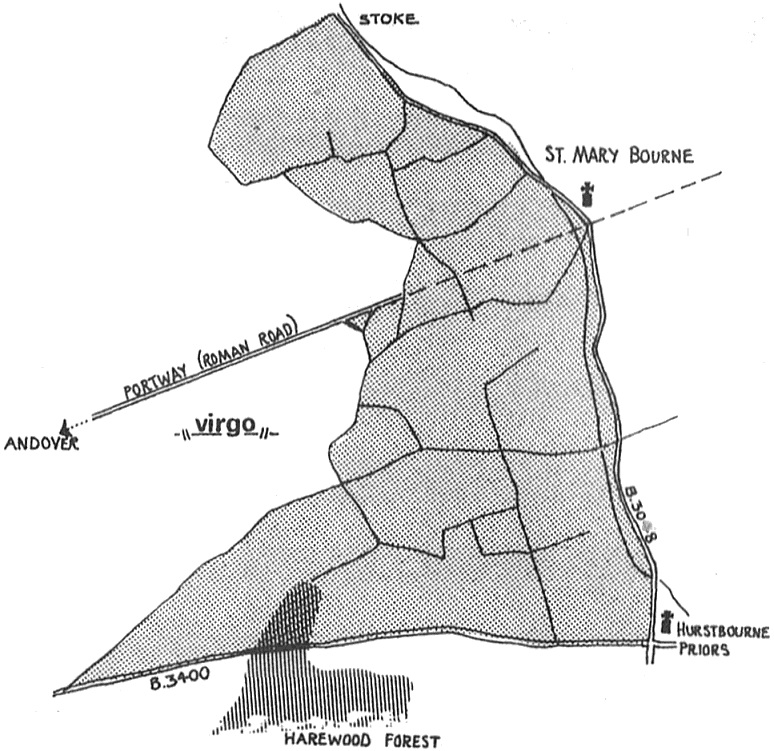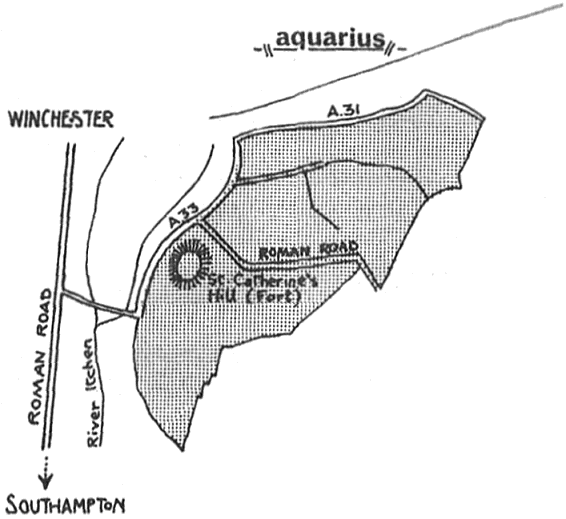
Journal of Geomancy vol. 3 no. 1, October 1978
{3}
This zodiac is situated in a region which has been saturated in history: Celts, Romans, Saxons and Normans have all seen the Winchester area as a place of importance and sanctity. The city has Arthurian connexions (which, by projection, link it with the cycle of legends surrounding the Glastonbury Zodiac) – for example, the reputed Round Tahle which is kept in the hall of Winchester Castle; it has its own saint, Swithun, a rain-bringer in true St David tradition. In its rôle as capital of Old England, Winchester is linked with William Rufus, son of William the Conqueror. The Red King, slain in the New Forest, plays an important part in the legends central to this particular terrestrial zodiac. The legends which bind the Winchester Zodiac together are an overlapping patchwork of lore and tradition, fragments linked mainly by their common locality: it is possible that these fragments are the component parts of an older, more coherent, mythological cycle, scattered and modified by the successive waves of invaders, each adding and subtracting to suit their own purpose.
The signs of Virgo, Capricorn and Sagittarius/Hercules now belong to the strain of legend surrounding William Rufus and his mysterious death; the twins of Gemini are now portrayed as Sir Bevis, hero of southern Hampshire, and his gigantic foe, Ascapart. Scorpio is transformed into the death-dealing cockatrice which once terrorized the Wherwell area, south of Andover. Pisces is the grampus (a dolphin-like creature) which came to roost in a yew tree by the church at Highclere. Such is the folklore of the region, upon which I have based any assumption for the existence of a terrestrial zodiac in the area.
In the reconstruction of the effigies, I have used, for the most part, roads, tracks and boundaries of proven or highly probable antiquity. Although one must, by necessity, occasionally be quite arbitrary in delineating such figures, I have tried to be as self-critical as possible without being destructive or disparaging.
A couple of the signs differ somewhat from the more usual concept of terrestrial zodiac iconography, but, wherever possible, I have tried to support these changes by referring to local folklore and tradition.
If any readers, especially those living in or near the Winchester area, have any criticisms or suggestions which they feel may be useful, I will be more than glad to hear from them. Fresh information in this field is always welcome, and I could certainly use all I can get. In the notes which follow, I have attempted to concentrate on giving basically the major ‘evidence’ for the existence of each sign, leaving out such smaller details as parish church dedications etc., other than those which seem to me significant. Evidence and outline for some of the signs are admittedly scanty, and I shall mention any lack of documentation or configuration as the notes proceed. {4}
To begin, I feel that I must explain the importance of William Rufus to this zodiacal mythos. With the Glastonbury Zodiac, the legends revolve around the figure of King Arthur, and his knights’ quest for the Holy Grail. Esoterically, Arthur represents the dying sun at the summer solstice: similar figures play an important part in many myth-cycles based on the personification of the phases of the seasonal cycle (e.g. Jesus Christ and Balder), and are often held to be awaiting the time when they can return, as saviours. Pagan fertility cults often chose a real person to represent this ‘Divine King’, who was then sacrificed at the appropriate time of year (or term of years) to perpetuate the seasonal cycle by sympathetic magic. I feel that the presence of such a figure is important to the concept of terrestrial zodiacs: it can be seen in the part played by St Edmund in the Ongar Zodiacal lore (IGR Occasional Paper Nr. 9 by Jim Kimmis – ed.). It has been suggested that Rufus’s killing was of a sacrificial nature – as a Red King (and therefore a solar figure) he is also identified with his own blood, which washed the countryside as his corpse was brought to Winchester, thus guaranteeing the continued fertility of the land. William Rufus died on August 2nd, the day after Lammas, traditionally one of the four great festivals of the Old Religion.
ARIES is undiscovered as yet. I can find no local lore relating to a ram, ewe or lamb: nor can I find any clues in place-names. More detailed work is needed here.
TAURUS is a beautifully described bovine head at Bullington. The horn and face are outlined by an unusually-shaped piece of woodland which also doubles as a district boundary. The age of this shape may be witnessed by the village of Sutton Scotney which is situated at the base of the horn – “Scotney” meaning a projecting piece of land. At the crossroads north of Bullington is the Bullington Cross Inn The upper line of the bull’s horn, and his back, are described by the A30.
GEMINI is still lost but legends relating to Sir Bevis and Ascapart prompt me to keep searching.
CANCER is also undiscovered … although there is a Crab Wood to the west of Winchester, out of its more likely position, yet perhaps a pointer.

LEO is a fine lion, part of whose head, alas, is missing – perhaps land clearance is to blame. He is outlined by old tracks and roads, and part of his front (lowered) leg is made by a parish boundary. Part of his back is the B3400 between Priory Farm, Laverstoke, and the town of Overton. The back of his neck is the road which runs from Overton to North Waltham. Oakley, on Leo’s raised forepaw, boasts the only parish church dedication to St Leonard that I have so far encountered in this particular area.
VIRGO, the first effigy I found on my search, was revealed to me in a vision – that of a monk who had a dream on the night of the death of William Rufus. In his dream, he saw a kneeling Virgin, surrounded by a heavenly host, praying to the saviour for the deliverance of the people from the hands of their evil (Pagan) king. {5} {6} She faces west (the dying sun) and, in relation to the other signs, it is in the ‘wrong’ attitude, facing away from the central point of the zodiac, and thus differs from other terrestrial zodiac ladies. St Mary Bourne is on her back, which is outlined by the intertwining of the Bourne Rivulet and the B3048. She is in a kneeling posture, and, as in the Glastonbury, Kingston, Ongar and Nuthampstead zodiacs, she is crossed by a Roman road (in this case, the Portway), and at a similar angle. To the south-west is Harewood forest (cf. the Pendle Zodiac). The supposed derivation of the name ‘Andover’ (which town she almost touches) raises an interesting suggestion. According to K. Cameron in his book English Place Names, the name means “ash-tree stream”, being of Celtic origin. However, I suggest that it may be derived from Ana (the leading figure of the trinity of Ana, Badb and Macha, the Irish/Celtic goddesses known collectively as the Morrigan or Great Queen i.e. the Triple Goddess or White Goddess) and “Dubh(r)”, Irish Gaelic for ‘black’ – in other words, Black Annis or Anna, the Goddess in her aspect as death-bringing hag. This theory is especially thought-provoking when one looks at the position of Scorpio. As an amusing coincidence, to the south-east of the figure is a Firgo Farm.
LIBRA, although usually a dove, appears in this instance to be a crow, outlined as it is by the complex of roads and tracks around Crawley (from the Anglo-Saxon, meaning ‘Crow Glade’). I do not apologise for this apparent reversal; crows and ravens were sacred to both Celtic Bran and Norse Odin, and used extensively for divinatory purposes. Considering the role of both gods as suffering for mankind’s benefit, they both fit well into the sacrificial theme of this zodiac. There is also the similarity between the words ‘dove’ and ‘dubh(r)’ (see above).
SCORPIO is sited just south of Andover, his sting actually touching the town’s centre: perhaps he is drawing his venom from the dark queen…? The beast is well shaped, although one of his claws has been amputated by the radio telescope/airfield complex between Chilbolton and Leckford (could the last place-name be derived from the Old English word ‘lich’ – a corpse?).
Scorpio may well be the original of the cockatrice which allegedly made its home in the Priory at nearby Wherwell (which incidentally means ‘cauldron springs’– a reference to the Great Cauldron of Life and Inspiration owned by the Goddess in her guise of Ceridwen?). This dark sign is partially outlined by the A3057 between Stockbridge and Andover; its only existing claw appears to be grasping for Meon Hill, by Stockbridge.
SAGITTARIUS lies to the south-west of Winchester. The lower part of the horse is outlined by the A31, the very road along which was carried Rufus’s body, gushing blood. The hind leg has disappeared beneath expanding Romsey and its railways. The rider is in the Horsley Forest area, and the town of Horsley lies on his steed’s head: Horsley is derived from the Anglo-Saxon word “hyrsa”,* meaning a mare. An interesting point (and one which I am unable to find any historical hints for) is that the woodland and footpath arrangements at the rider’s head have apparently conspired with fate to give him a horse-like ‘mask’.
EDITOR’S NOTE * Hyrsa, a mare = Horsa, with Hengist, the Saxon founder of the English nation. Horsley, like Horstead must be associated with this semilegendary figure. Research on Hengist and Horsa now underway will be published in a future issue of ALBION.

CAPRICORN is indefinite: this goat lies around Eastleigh, to the south of Winchester. His limbs have seemingly been destroyed by railways, a sewage works and Southampton airport. He is a hump-backed specimen, and his horn is the antique fish-pond at Fisher’s Pond. On his head is Nob’s Crook, which adds to his sinister aura, ‘Nob’ (like ‘hob’) being a name associated with goblins and Old Nick.
AQUARIUS is directly adjacent to Winchester itself. Outlined by tracks and roads of definite antiquity, the figure is similar to the Aquarius of Glastonbury. St Catherine’s Hill (with its fiery connotations and its maze) performs the same function as that of the Tor at Glastonbury, being the head of the phoenix–eagle. As at Glastonbury. the bird appears to be drinking, in this case from the River Itchen. I can find no meaning for the name of this river, although I have read that it is Celtic in origin. Bird-names abound in the vicinity of this effigy (e.g. Larkwhistle, which is also present near Libra; Owslebury, which pertains to owls). Is it possible that the first element in the name of Winchester is a pun on ‘earn’, Anglo-Saxon for ‘eagle’?{7}
PISCES is a puzzle. I have found two vaguely fish-like shapes to the west of Winchester, but I am dissatisfied with these. The legend of the grampus of Highclere, however, is encouraging. The story goes that this sea mammal took up residence in a yew tree near the local church, and so annoyed the populace with its noisy breathing and its fondness for chasing the villagers, that it was banished by a priest to the Red Sea (red again) for a thousand years. According to the tale, the date of exile has been forgotten, so no-one knows when it will return. Perhaps it will soon be rediscovered…
This zodiac, like that of Holderness, is oriented with Leo to the north. So far, it appears to be somewhat elliptical in shape, and is constructed around (or so it seems) an axial Roman road which runs north-west to south-east, going through Andover toward Winchester. It is situated directly west of the Alton Zodiac discovered by Michael Behrend.